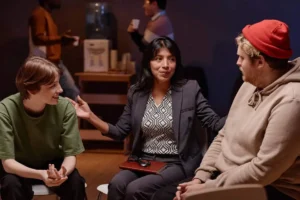A New Way To Treat Kids, Teens And Young Adults With Anxiety
Our clinicians were recently trained by Dr. Eli Lebowitz of Yale University in an exciting new way of alleviating anxiety in kids, teens and young adults.
Our clinicians were recently trained by Dr. Eli Lebowitz of Yale University in an exciting new way of alleviating anxiety in kids, teens and young adults. This approach was highlighted in an article in the Atlantic “What happened to American Childhood? Too many kids show worrying signs of fragility from a very young age. Here’s what we can do about it” and immediately sparked my interest. For a long time, we at CCTA have been stressing the importance of parent participation in the Cognitive Behavioral (CBT) therapeutic approach. Now the COVID-19 pandemic has presented new challenges for parents of anxious children because we have more time at home together, with less boundaries and physical space between parents and kids, and fewer outside activities to structure kids’ lives. Children who were prone to avoiding school, sleepovers, and social situations pre-COVID, now spend all of their time at home, and are not being challenged to face their fears because of COVID rules.
When I learned about the Supportive Parenting for Anxious Childhood Emotions (SPACE) training, I saw the opportunity to reach more anxious kids and their families. This is a completely parent-based intervention, which allows us to treat children who may be unresponsive or resistant to individual cognitive behavioral therapy or medication. We may choose to treat parents and kids with the SPACE program when kids are willing to participate, but we can address children’s anxiety through parent participation alone.
SPACE Addresses Family Accommodation
The overall goal of the SPACE program is to follow a structured path leading to decreased family accommodation of a child’s anxiety and better parental support.
What is family accommodation and why should we aim to decrease it? Accommodating a child in distress is a natural thing to do- all parents accommodate. Parents accommodate because they are attentive and have a hard time seeing their child suffer. Sometimes we accommodate because we need to get on with our day and we know the accommodation will “solve the problem.” That is usually true, but only in the short term. When we accommodate, the child’s distress decreases immediately as the accommodation takes the stressor away, and the child does not have to cope with their fear or discomfort. The problem is that every time we accommodate, the child and the parent become more and more convinced that the only way for the child to function is to be accommodated. The next time a similar situation appears, the child is more likely to ask for the accommodation and we are more likely to provide it. This leads to a maintenance of symptoms, and frequently to even more severe symptoms. Although accommodation is well-intentioned, by engaging in it we are actually depriving the child of opportunities to learn that they can cope with more distress than they actually thought.
Examples include: sleeping next to a child who fears being in bed alone, not going out in the evening or only using one particular babysitter, answering questions related to a child’s worry and speaking in place of child with social anxiety.
Accommodation is present in 95% of parents of anxious children and is associated with more severe anxiety symptoms and more impairment for the child and the family. A growing body of evidence (O’Connor et al, 2020) suggests that too much parental accommodation can make a child’s anxiety symptoms worse over time and may lead to debilitating anxiety in adulthood. Further, high family accommodation predicts poor treatment outcome and can lead to additional problems such as sleep problems and school refusal among others. This means that your child could be successful in their CBT treatment for anxiety, but fail to maintain gains because of family accommodation.
SPACE Teaches Parental Support
Many parents of anxious children are torn between the need to help their child feel better or get things done and the desire to show them that there is no real danger and that they can manage on their own. Being the parent of an anxious child means facing that dilemma thousands of times. What we have found is that, in fact, children respond the best when parents are able to combine both of these ideas into one message. In other words, the best reactions from parents to children’s fears are those that combine an acceptance and legitimization of children’s fears with a belief in that child’s ability to withstand slightly more anxiety that they have until now. When parents are only accepting the child’s fear and reassuring them or helping by avoiding the anxiety, we call that “protection”. When parents only expect their children to act bravely without recognizing the difficulty or accepting that the process may be gradual, we call that “demanding.”
Support combines the two approaches. An example of a supportive response may be, “I see this is hard for you and I’m 100% sure you can handle it.”
Parents’ initial reaction to the SPACE program may be “Are you saying that this is my fault?” They may feel blamed or criticized for their child’s anxious presentation. But just because parent training is the target does not mean that parents are the problem. They are just a huge part of the solution. We are proposing that we treat your child’s anxiety by helping them get better at managing the situations that make them fearful and that they have been avoiding until now. This approach focuses on changing parent behavior as opposed to directly changing the child’s behavioral, cognitive and emotional patterns. This can actually avoid much of the escalation that stems from trying to force their child to act differently.
SPACE involves teaching the parent to be supportive, firm, and confident, choosing a specific target behavior, and then coaching the parents throughout the process. Therapists make a specific plan with the parents and then troubleshoot when resistance or disruptive behaviors come up at home. Once the target behavior is extinguished, the team moves onto a new target behavior. Eventually (the goal being after 12 sessions), parents learn how to reduce accommodations on their own and no longer need the therapist’s help.
This approach also addresses the need for collaboration between parents, and works on differences between parents in how their child’s anxiety is approached. Finally, this approach can also be used with young adults often characterized as “failure to launch” who are having difficulty moving through the transitions of early adulthood.
Dr. Katie O’Meara, Psy.D, Director






